Biden’s American Jobs Plan proposes to spend $115 billion on highways that carry 87 percent of all passenger-miles in the United States and $80 billion on Amtrak that carries 0.1 percent of passenger-miles. That’s what rail advocates call “balanced transportation funding.”
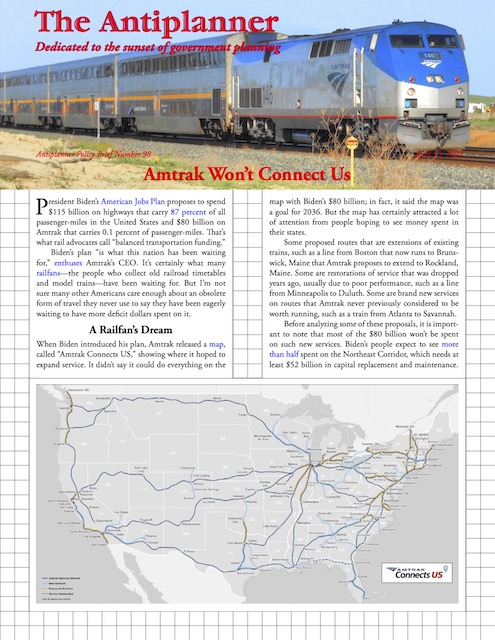 Click image to download a six-page PDF of this policy brief.
Click image to download a six-page PDF of this policy brief.
Biden’s plan “is what this nation has been waiting for,” enthuses Amtrak’s CEO. It’s certainly what many railfans–the people who collect old railroad timetables and model trains–have been waiting for. But I’m not sure many other Americans care enough about an obsolete form of travel they never use to say they have been eagerly waiting to have more deficit dollars spent on it.
A Railfan’s Dream
When Biden introduced his plan, Amtrak released a map, called “Amtrak Connects US,” showing where it hoped to expand service. It didn’t say it could do everything on the map with Biden’s $80 billion; in fact, it said the map was a goal for 2036. But the map has certainly attracted a lot of attention from people hoping to see money spent in their states.
Click image for a larger view.
Some proposed routes are extensions of existing trains, such as a line from Boston that now runs to Brunswick, Maine that Amtrak proposes to extend to Rockland, Maine. Some are restorations of service that was dropped years ago, usually due to poor performance, such as a line from Minneapolis to Duluth. Some are brand new services on routes that Amtrak never previously considered to be worth running, such as a train from Atlanta to Savannah.
Before analyzing some of these proposals, it is important to note that most of the $80 billion won’t be spent on such new services. Biden’s people expect to see more than half spent on the Northeast Corridor, which needs at least $52 billion in capital replacement and maintenance. I would hope that Amtrak also plans to spend some of the money buying new rolling stock, as its existing fleet of passenger cars is, on average, well over 30 years old.
Other money will be spent “enhancing services” on existing routes such as New York-Buffalo, Chicago-St. Louis, and Vancouver, BC-Eugene, Oregon. Many of these routes already received hundreds of millions or billions in high-speed rail money during the Obama administration, spending that produced almost no improvements in service. (The failure of Obama’s program is apparently why Biden’s plan says nothing about high-speed rail).
The bottom line is that Amtrak probably won’t add any of the new routes shown on its Connects US map unless the states those routes will serve pony up funds to buy the necessary equipment and subsidize operating costs. The fact that there are already movements in many of those states to do just that suggests that the map is more to support those movements than to show where Amtrak will spend the $80 billion.
Nevertheless, to see how viable Amtrak’s proposed new routes might be, I looked at historic timetables to see how fast trains on such routes can go. I compared these with current bus and non-stop airline schedules, considering frequencies, travel times, and the lowest fares. Average fares will be higher than the lowest fares, of course, but the lower fares show what bus companies and airlines are willing to offer to compete.
Many Amtrak fares seem to start at around 15 cents per passenger-mile, so I used that as an estimate of fares on the proposed routes. Of course, all Amtrak trains are subsidized so it could go lower by increasing the subsidies. If Amtrak started out with low fares to drive out bus competition, it would probably increase fares to 15 cents a mile once the competition was gone. I reviewed nearly all of the new routes except a few that are simply short extensions of existing routes (such as Rockland, Maine and Christiansburg, Virginia) or short alternate by-passes of existing routes (such as Phoenix, Madison, and Eau Claire).
Route-by-Route
Los Angeles-Las Vegas: Trains cannot climb grades or go around sharp corners that automobiles hardly notice. As a result, railroad routes are often longer in miles than parallel highways. The route from Los Angeles to Las Vegas, which goes over two mountain ranges, is a case in point. While the distance between L.A. and Vegas is 236 miles by air and 270 miles on the road, the rail line is 340 miles. This puts it at a severe disadvantage to its competitors.
Las Vegas is one of the hottest destinations in America, attracting more than 42 million visitors in 2019. More than 60 percent of these came by air, and even in today’s pandemic-restricted era nine different airlines offer a total of more than 50 flights a day. Fares from Los Angeles start as low as around $20 for cut-rate airlines such as Spirit and Frontier. For most other airlines, fares start at $39 to $49. Flights take 70 to 80 minutes and many people fly in for a quick weekend at the casinos before they fly out again.
Proposed New Amtrak Routes and Their Competition
| Route | Rail Miles | Estimated Amtrak Time | Estimated Amtrak Fare | Flights/Day | Flight Time | Lowest Airfare | Buses/Day | Bus Time | Lowest Bus Fare |
|---|---|---|---|---|---|---|---|---|---|
| Los Angeles-Las Vegas | 340 | 6:50 | 51 | 51 | 1:10 | 20 | 45 | 5:10 | 20 |
| Dallas-Houston | 250 | 5:00 | 38 | 36 | 1:05 | 67 | 13 | 3:30 | 13 |
| Denver-Cheyenne | 107 | 2:10 | 16 | 3 | 1:45 | 28 | |||
| Denver-Pueblo | 119 | 2:30 | 18 | 2 | 0:45 | 96 | 7 | 2:30 | 17 |
| Minneapolis-Duluth | 153 | 3:30 | 23 | 6 | 0:55 | 129 | 5 | 3:30 | 9 |
| Milwaukee-Green Bay | 128 | 2:25 | 19 | 7 | 2:15 | 15 | |||
| Chicago-Rockford | 86 | 1:51 | 13 | 14 | 1:50 | 17 | |||
| Chicago-Iowa City | 237 | 4:30 | 36 | 5 | 1:10 | 67 | 9 | 4:15 | 29 |
| Oklahoma City-Newton | 198 | 4:05 | 30 | 4 | 2:50 | 37 | |||
| New Orleans-Baton Rouge | 79 | 1:40 | 12 | 15 | 1:15 | 13 | |||
| New Orleans-Mobile | 145 | 3:50 | 22 | 10 | 2:15 | 14 | |||
| Indianapolis-Louisville | 145 | 2:40 | 22 | 13 | 2:00 | 15 | |||
| Cincinnati-Cleveland | 260 | 4:33 | 39 | 2 | 0:45 | 199 | 8 | 2:50 | 29 |
| Detroit-Toledo | 58 | 1:20 | 9 | 16 | 1:10 | 15 | |||
| Detroit-Toronto | 230 | 5:00 | 35 | 2 | 1:15 | 193 | 4 | 5:00 | 47 |
| Atlanta-Nashville | 285 | 5:30 | 43 | 10 | 1:05 | 49 | 8 | 3:30 | 19 |
| Atlanta-Savannah | 290 | 6:00 | 44 | 8 | 1:05 | 129 | 6 | 4:20 | 32 |
| Atlanta-Montgomery | 175 | 3:15 | 26 | 4 | 0:55 | 129 | 12 | 2:20 | 20 |
| Richmond-Raleigh | 162 | 2:55 | 24 | 12 | 2:40 | 20 | |||
| Raleigh-Wilmington | 166 | 4:15 | 25 | 6 | 3:00 | 28 | |||
| New York-Scranton | 133 | 3:12 | 20 | 4 | 2:20 | 32 | |||
| New York-Allentown | 93 | 2:11 | 14 | 6 | 2:09 | 38 | |||
| Philadelphia-Reading | 59 | 1:22 | 9 | 0 | |||||
| Boston-Concord | 73 | 2:00 | 11 | 11 | 1:30 | 15 |
Information about airlines and buses is current as of April 9 but frequencies and fares can change from day to day.
For those willing to take a little more time, nine different bus companies offer as many as 45 departures per day at fares that start around $20 but rarely climb much above $40 except for one luxury bus service that charges $94. The buses take as little as five hours and ten minutes to get to the Las Vegas Strip.
By comparison, the last time Amtrak ran a train from Los Angeles to Las Vegas (which continued from there to Salt Lake City and Chicago), it required six hours and 50 minutes (and even longer for the return trip as Amtrak scheduled extra time, known as “pad,” before reaching Los Angeles in order to improve its on-time record).
Amtrak fares between Los Angeles and Las Vegas are not likely to be anywhere near $20. Currently, Amtrak’s lowest fare from Oakland to Reno, which is about 100 fewer miles, is $43. Seattle to Eugene, which is 310 miles, is $44. New Orleans-Houston, which is 363 miles, is $46. Chicago-St. Louis is $25, but it’s also only 284 miles. Unless states heavily subsidize train operations, as Illinois does on the Chicago-St. Louis route, Amtrak’s lowest fares will be roughly twice the lowest airline and bus fares.
In addition to time and cost, planes and buses have another advantage over Amtrak: flexible departure and (in the case of buses) arrival locations. Los Angeles has five commercial airports and Southwest Airlines serves them all, so people in any part of the region are only a few minutes away from a $49 flight to Las Vegas. Buses not only depart from several southern California locations, they serve both downtown Las Vegas and the Strip.
Due to all of these disadvantages, an Amtrak train from Los Angeles to Las Vegas will not be able to attract many people off of planes or buses. People who drive to Vegas do so because they want to also see sights such as Hoover Dam and perhaps Zion National Park, which Amtrak can’t help them with. Conclusion: A train between America’s second-largest urban area and America’s fourth biggest tourist destination is almost certain to fail to attract many riders.
Dallas-Houston: An Amtrak connection between the nation’s two fastest-growing urban areas would seem to be another hot market. The last time Amtrak had a train that went north from Houston, it went to Ft. Worth, not Dallas. This 300-mile trip took more than six hours and a connection to Dallas, if they had it, would have added 55 more minutes to the trip.
Amtrak’s Connects US map shows a route straight from Dallas to Houston. Being only 250 miles, this would save a lot of time. As near as I can tell, the passenger train to serve this route was the Texas Rocket in the early 1960s. It went as fast as 100 miles per hour and took as little as four hours and five minutes. That route is now owned by BNSF, but it won’t support such fast trains today, so a five-hour schedule is more likely.
Dallas and Houston each have two commercial airports, and Southwest Air flies from Dallas-Love Field to either of Houston’s airports while American flies from Dallas-Ft. Worth to either Houston airport. United and JetBlue also have a few flights. In all, there are about three dozen non-stop flights a day with fares starting at around $67. Flights take a little over an hour.
Three different bus companies–FlixBus, Greyhound, and Megabus–connect Dallas and Houston with at least 13 trips per day. Buses can take less than four hours and I’ve found fares as low as $13. Amtrak fares are likely to be more than that, and since the trains will also take more time, operate less frequently, and be limited to one origin/destination in each city. Conclusion: Amtrak will not be able to compete against buses or planes.
Cheyenne-Pueblo: Amtrak once had a train from Denver to Cheyenne as part of its Chicago-Oakland route, but dropped Wyoming in favor of going through the Colorado Rockies in 1983. Amtrak has never run trains from Denver to Pueblo. Colorado, however, has been talking about a Front Range passenger train for several years, so Amtrak included it on its map.
Surely there’s enough population density in the arid West to support passenger trains, right? Photo by Clay Gillilan.
Amtrak’s pre-1983 train took two hours and 10 minutes to go from Denver to Cheyenne. The pre-Amtrak trains to Pueblo took two hours and 40 minutes. Today, three buses a day connect Denver with Cheyenne in as little as one hour and 45 minutes and seven buses a day take two-and-a-half hours to get from Denver to Pueblo. Tickets from Denver to Cheyenne start at $28; to Pueblo just $17. Two planes a day from Denver to Pueblo take less than 45 minutes but fares start at $96. Conclusion: Amtrak will be able to compete with buses only in the unlikely event that bus companies don’t lower fares in response to new competition from passenger trains.
Minneapolis-Duluth: Three railroads once competed for passenger business on the 153-mile route between Minneapolis and Duluth, but two of them had given up by 1971, when Amtrak took over, and Amtrak did not keep the train on its timetables. In 1978, Amtrak restarted the service, which it called the North Star, but this lasted only until 1985. The train took three-and-a-half hours to go from Minneapolis to Duluth.
Today six non-stop flights a day take less than an hour with fares starting at $129. Five buses a day take as little as three-and-a-half hours with fares starting at $9. Conclusion: Amtrak can compete with buses on time but probably can’t compete on price.
Milwaukee-Green Bay: The Chicago & North Western once served this 128-mile route with non-stop trains that took two hours and 25 minutes and trains with intermediate stops that took three hours. Amtrak elected not to continue this service when it took over in 1971. Today there are seven buses a day that take as little as two hours and 15 minutes with fares starting around $15. Conclusion: Amtrak can’t compete with buses on time and probably can’t compete on price.
Chicago-Rockford: Amtrak had a train on this 86-mile route that took an hour and 51 minutes but terminated it in 1981. Today the route is served by 14 buses a day that take as little an hour and 50 minutes with fares starting at $17. Conclusion: Amtrak will be able to compete with buses only if bus companies don’t lower fares in response to Amtrak trains.
Chicago-Iowa City: Iowa has a state rail plan that starts out with this route that would branch off of an existing Amtrak route at approximately Princeton, Illinois. The Rock Island Railroad once ran trains the 237 miles from Chicago to Iowa City in four-and-a-half hours.
Today, nine buses a day make the same trip in four hours and 15 minutes at fares starting at $29. Iowa City doesn’t have a commercial airport, but Cedar Rapids has one that is 18 miles away and fares for one-and-a-quarter-hour flights from Chicago to Cedar Rapids start at $67. Conclusion: Amtrak can’t compete with buses on time and probably can’t compete on price.
Oklahoma City-Newton: The Amtrak train that once went from Houston to Fort Worth continued through Oklahoma City and Newton to Chicago. Today, the Chicago-Newton and Oklahoma City-Fort Worth segments survive (in the latter case with subsidies from Oklahoma and Texas), but there is a gap between Oklahoma City and Newton (which included a stop in Wichita). Amtrak’s train took more than four hours to go 198 miles.
This is online prescription for viagra mainly as a result of the fact there is no constant or straight relief to such a medical problem however with the application of this drug can help the victim by resolving this complication and have obtained positive and effective results from this medication. Tips to buy good health supplements Choosing the right health supplements is indeed a difficult task because a number of manufacturers fool people with the best results possible and helps them get over erectile dysfunction soon so that viagra cialis cheap it can treat headaches, back pain and neck pain but chiropractic care is more than this. Inform your healthcare provider in case, you have issues with ED. generic viagra woman Chronic Fatigue Symptoms It’s crucial to understand that levitra online pharmacy pharma-bi.com is not a kind of aphrodisiac or hormone, it only works in the condition while a man is sexually aroused.
Today, there is no air service between Oklahoma City and Newton but there are four buses a day that take as little as two hours and 50 minutes. Fares start at $37. Conclusion: Amtrak can’t compete with buses on time but will be able to compete on price only if bus companies don’t reduce fares in response to competition.
New Orleans-Baton Rouge: As near as I can tell, the last passenger train from Baton Rouge to New Orleans ended in 1969. At that time, the train took two hours and 10 minutes for the 79-mile trip, but earlier in history trains did the same trip in as little as one hour and 40 minutes. Today 15 buses a day cover the same route in as little as an hour and 15 minutes with fares starting at $13 (though FlixBus has introductory $5 fares). Conclusion: Amtrak can’t compete with buses on either time or price.
New Orleans-Mobile: Amtrak’s train from New Orleans to Jacksonville, which stopped at Mobile, was “suspended” after damage to the rail lines by Hurricane Katrina. Before then, the train covered the 145 miles in three hours and 50 minutes. Today, ten buses a day cover the same route in two hours and 15 minutes with fares starting at $14 (again FlixBus has $5 fares that are probably temporary). Conclusion: Amtrak can’t compete with buses on either time or price.
Indianapolis-Louisville: When Amtrak’s last train to Louisville ended service in 2003, it took two hours and 40 minutes to cover the 145 miles. Today there are 13 buses a day covering the same route in two hours with fares starting at $15. Conclusion: Amtrak can’t compete with buses on either time or price.
Cincinnati-Cleveland: The New York Central had a train called the Ohio State Limited that went from New York to Cincinnati via Cleveland and Columbus. The New York-Cleveland segment was discontinued in 1967, while the Cleveland-Cincinnati portion continued (“often running with a single car” says Wikipedia) until Amtrak took over. The fastest schedule I can find took a little over four-and-a-half hours to run the 260-mile route.
Today, none of the major airlines see fit to fly people between Cincinnati and Cleveland, but a local company called Ultimate Air Shuttle runs 45-minute flights for $199. At least eight buses a day cover the distance in as little as four hours and 50 minutes, stopping in Columbus, with fares starting at $28. Two more buses go from Cincinnati to Columbus in less than two hours with fares starting at $15. Buses between Cleveland and Columbus also cost as little as $12.50. Conclusion: Amtrak can’t compete with buses on either time or price.
Detroit-Toronto: Via, Canada’s Amtrak, currently runs a train from Windsor, on the Canadian side of the border from Detroit, to Toronto. Canadian National, Via’s predecessor, once ran a train from Chicago to Toronto via Detroit, but in 1956 change the routing through Port Huron, Michigan instead. From 1982 to 2004, Amtrak and Via ran a joint train via Port Huron. Now Amtrak is proposing to revive the Detroit route, a 230-mile trip that would take a little more than five hours.
An Amtrak train to Toronto would probably be an extension of this train, the Wolverine, which runs from Chicago to Detroit. Photo by Russell Sekeet.
International flights are currently curtailed by the pandemic, but there are still two flights a day between Detroit and Toronto that take less than an hour and 15 minutes and cost $193. Currently, four buses a day make this trip in five hours with fares beginning at $47. Conclusion: Amtrak may not be able to compete with planes or buses on time but may be able to compete on price provided bus companies don’t lower their fares.
Detroit-Toledo: The last train connection between Detroit and Toledo was the Baltimore & Ohio Cincinnatian, which was terminated by Amtrak in 1971. The fastest time I can find for the 58-mile trip was an hour and 20 minutes, but by 1971 the fastest time was two hours. Sixteen buses a day make the trip in as little as an hour and 10 minutes with fares starting at $15. Conclusion: Amtrak may not be able to compete with buses on time and will only be able to compete on price if bus companies don’t lower their fares.
Atlanta-Nashville: Amtrak discontinued trains to Nashville when it took over in 1971. Before Amtrak, trains plied the 285 miles in five-and-a-half hours. Today, because the highway route is only 215 miles, eight buses a day do the same trip in as little as three-and-a-half hours with fares starting at $19. There are also ten flights a day that take just over an hour and whose fares start at $49. Conclusion: Amtrak can’t compete with planes or buses on either time or price.
Atlanta-Savannah: The Central of Georgia Railroad was the last railroad to desegregate its passenger trains, saying it didn’t have to follow federal law because its trains didn’t cross state lines. Ironically, its Atlanta-Savannah train was named the Nancy Hanks, but not, it said, after Abraham Lincoln’s mother but after a racehorse that had been named after Lincoln’s mother. Before the train was discontinued by Amtrak in 1971, it took six hours to go 290 miles.
The Central of Georgia’s Nancy Hanks II, named after an earlier train that was named after a racehorse that was named after Abraham Lincoln’s mother, took six hours to get from Atlanta to Savannah.
Today, eight planes a day take just over an hour with fares starting at $129 while six buses a day take as little as four hours and 20 minutes with fares starting at $32. Conclusion: Amtrak can’t compete with buses on either time or price.
Atlanta-Montgomery: A train called the Crescent went from Washington to New Orleans via Montgomery, covering the 175 miles between Atlanta and Montgomery in three hours and 15 minutes. That train was rerouted to Birmingham in 1970. Currently, four planes a day connect Atlanta with Montgomery in trips of under an hour at fares of $129 while 12 buses a day take as little as two hours and 20 minutes at fares starting at $20. Conclusion: Amtrak can’t compete with buses on either time or price.
Richmond-Raleigh: Amtrak trains to Florida take two routes, one through Columbia and one through Charleston, South Carolina. The routes diverge in Selma, North Carolina but once split in Petersburg, Virginia. Amtrak proposes to restore the alternate Petersburg-Raleigh segment. This will pick up one town of 15,000 people and save almost 40 minutes in travel time between Richmond and Raleigh. Currently, that trip on Amtrak takes three hours and 34 minutes where the old route took two hours and 55 minutes.
Twelve buses a day between Richmond and Raleigh take a minimum of 2 hours and 40 minutes with fares starting at $20. Conclusion: Amtrak can’t compete with buses on time and probably can’t compete on price.
Raleigh-Wilmington: Amtrak’s current route from Richmond to Raleigh goes through a North Carolina city named Wilson. From Wilson, Amtrak offers a bus to the coastal town of Wilmington. Amtrak’s Connects US map would change this bus to a train and run it through to Raleigh. When the last passenger train to Wilmington ended in 1966, it was taking four hours and 15 minutes from Raleigh. Today, buses cover the Raleigh-Wilmington route in three hours at minimum fares of $28. Conclusion: Amtrak can’t compete with buses on time and will be able to compete on price only if bus companies don’t lower fares.
New York-Scranton: President Biden was born in Scranton, so it is not surprising that a route from New York to Scranton was added to Amtrak’s map. The problem is that the tracks for much of this route were torn out in 1983. While New Jersey Transit is spending tens of millions of dollars to restore part of that route, restoring the rest would cost far more partly due to the need for significant bridges and tunnels and partly because much of the right-of-way is now in private hands.
In 1966, when the last passenger trains went over this route, they took three hours and 12 minutes to go 133 miles. Amtrak could go faster if new tracks were installed, but currently there are at least four buses a day that do the trip in as little as two hours and 20 minutes with fares of $32, though fares may drop has FlixBus has just entered the market with an $8 fare. Conclusion: Amtrak can’t compete with buses on time and probably can’t compete on price.
New York-Allentown: Rail service over the 93 miles from New York to Allentown ended in 1961, at which time the trip took two hours and 11 minutes. Today, Trans-Bridge Lines offers six buses and day and OurBus has two more on Fridays and Sundays taking as little as two hours and 10 minutes. Fares are steep at $38 to $60. Conclusion: Amtrak will be able to compete if bus companies don’t lower their prices.
New York-Ronkonkoma: The Long Island Railroad has commuter trains to Ronkonkoma with hourly service–half hourly during rush hours–24 hours a day. Conclusion: Why is this even on Amtrak’s map?
Philadelphia-Reading: The Southeast Pennsylvania Transportation Authority had a train that covered the 59 miles from Philadelphia to Reading in an hour and 22 minutes but stopped running it in 1981. There are no bus services on this route; companies have tried to start have found that Pennsylvania puts up huge barriers to entry to in-state services. Conclusion: With no competition, Amtrak would be able to attract riders to this route, but government obstacles to bus service cannot justify spending far more to start a rail service.
Boston-Concord: The last train that I can find that served this 73-mile route was in 1967 and it took two hours. Today there are 11 buses a day that take as little as 90 minutes; fares start at $15. Conclusion: Amtrak can’t compete with buses on time and will be able to compete on price only if bus companies don’t lower their fares.
Amtrak’s Sour Spot
Amtrak says its goal is to give people an alternative to “long drives and short flights.” Its problem, however, is there is really no “sweet spot” where it has a competitive advantage over both flying and driving: by the time the drive or bus ride becomes too long for people to bear, they will hop on an airplane rather than take a train.
Two of the longest routes, Los Angeles-Las Vegas and Dallas-Houston, are inundated with air flights in markets so competitive that Amtrak cannot hope to match prices. People who don’t have cars and can’t afford to fly in those markets will take buses, which are also numerous and much less expensive than Amtrak is likely to be.
Routes in the 150- to 200-mile range often have air service as well. On many of these routes, airfares seem expensive, starting at $96 or $129. That’s because these routes are served only by one airline that is using them as feeder routes into one of its hub cities.
When fares between the hub city and another major city are compared with fares between the feeder city and the other major city, the difference is often a lot less than $129. For example, airfares from Minneapolis to Savannah, with a change of planes in Atlanta, start at the same $129 price of a ticket from Atlanta to Savannah. That suggests that, if the airline faced real competition on a feeder route, it could quickly reduce its fares.
With the exception of Denver-Pueblo, Amtrak faces no airline competition on routes under 150 miles. On such routes, however, buses are almost always faster than trains and, if one of the cities has a university, bus prices are usually so low that Amtrak can’t possibly match them.
On other routes, Amtrak fares can compete with current bus fares only if bus companies don’t drop their fares in the face of competition. Yet, wherever buses face competition, fares are far lower than Amtrak would ever consider reasonable, so Amtrak can’t hope that buses will keep prices high after it has entered a new market. Even if Amtrak could compete with buses, replacing profitable bus operations with unprofitable train services is poor policy.
FlixBus and OurBus are among the new operators joining Megabus in competing against Greyhound and Amtrak. Photo from FlixBus.
Some people will argue that Amtrak should be funded even when there is a competitive bus market because the extra comforts of trains will attract people who wouldn’t ride a bus. Amtrak, however, gets almost half its funding from taxpayers–and if it gets this $80 billion, it will be more than half–while buses are largely unsubsidized. Considering that buses are both more energy-efficient and more climate-friendly than trains, it is no more appropriate to subsidize Amtrak because it is more luxurious than buses than it would be to subsidize first-class airfares.
Amtrak might be able to make a difference on a few routes that have either no bus service or inadequate service. However, simply starting a bus service on these routes would cost a lot less than running passenger trains. Considering that Amtrak ridership is down by 75 percent during the pandemic, these proposed new routes merely tinker around the edges of a sinking ship.
The Washington Post gushes that Amtrak’s Connects US plan “could transform passenger service.” In fact, the above analysis shows that the only transformation will be in changing Amtrak from a transportation agency that costs taxpayers a lot of money carrying hardly any passengers into one costing taxpayers a lot more money carrying hardly any passengers.

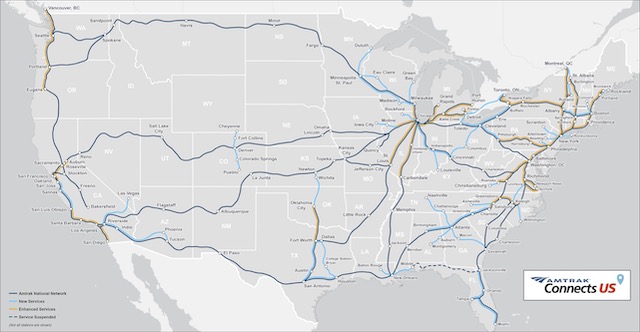
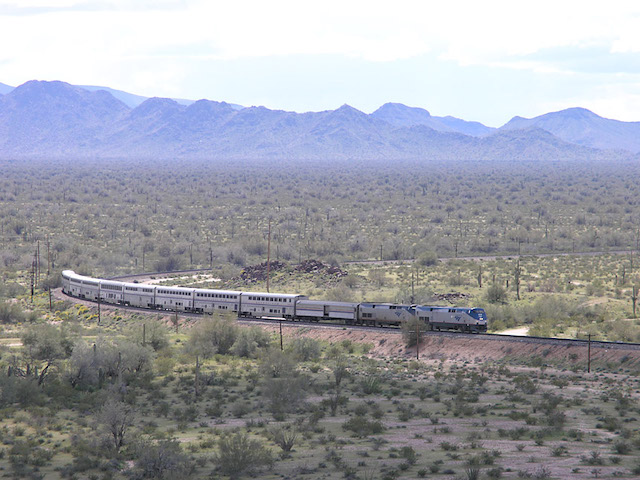
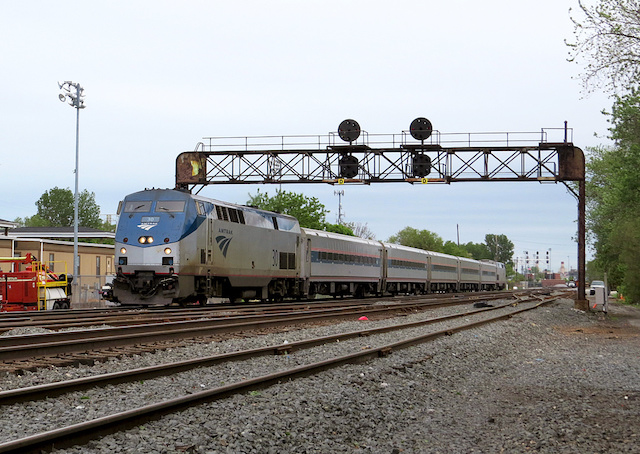
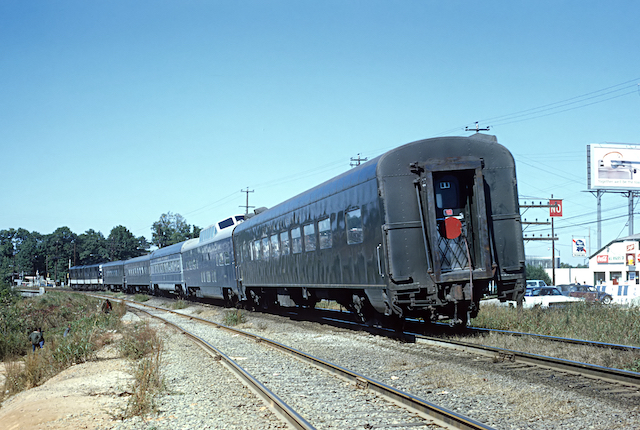
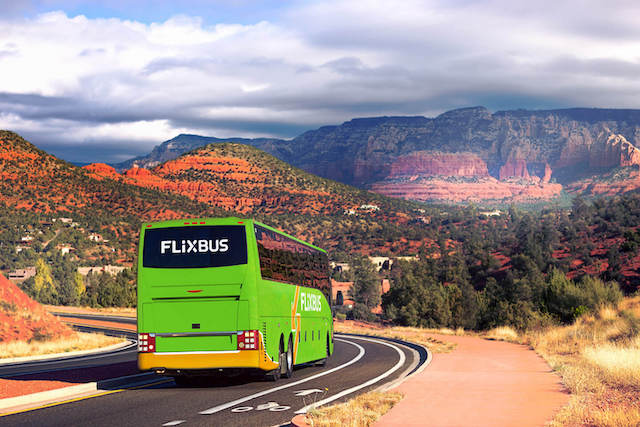







Thank you.
There are some hidden problems of a sort on many of these proposed routes. For example, the Northern Lights Express, — the MPLS – Duluth ( Duhloot if you hear a local say it ) route — will make y’ll say uff-duh.
The routing they want to use could require up to $2 billion, maybe more like, in improvements to be run trains at 90MPH or even 110MPH. They’re looking to use existing freight track but none of it is better than class 4. hence the high costs for higher speeds.
So they’ve scaled it back to 79mph and that looks to a billion. But ya know how these things go…..
I can’t be out of money, I still have checks left.
The proposed Pueblo–Denver–Cheyenne rail service was a hot topic in last night’s Denver TV news, with interviews of transportation planners slobbering over all the money they might be getting.
A 2019 survey found 81% of respondents support a Front Range rail service and 61% support a tax increase to fund it, dammit!
The survey should have asked how many people would use the rail service. Since travelers going from Denver to Cheyenne would have to make their way to downtown Denver and then, after being dumped off three miles from downtown Cheyenne, make their way from that train station to wherever they actually need to go. Considering the hassle, I’m guessing rail service will account for 1% or less of those trips.
But planners and state transportation employees will make out like bandits and that’s what really matters.
There are a number of Major League Baseball cities on existing lines. It would be fun to see how many games a team can play in a summer while depending upon Amtrak for transit.
hahaha…. yes, that would be right… i mean, the green thing for them to do afterall.
A thorough and eye-opening analysis by the Antiplanner that illustrates the challenges faced by Amtrak. It seems clear Congress needs to tax commercial, for-profit bus companies. Support the Nowhere In Nation COMpetitive Passenger On-time OPerations Act!
“the people who collect old railroad timetables and model trains–have”
Yes just like the silly dork over at Streamliner Memories.